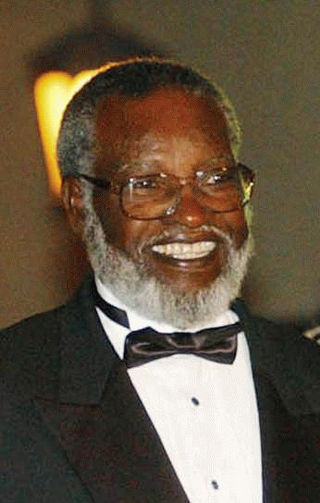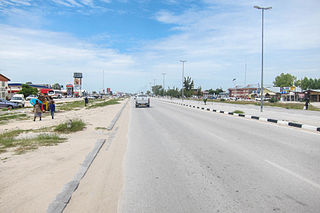Related Research Articles
The history of Namibia has passed through several distinct stages from being colonised in the late nineteenth century to Namibia's independence on 21 March 1990.

The South West Africa People's Organisation, officially known as the SWAPO Party of Namibia, is a political party and former independence movement in Namibia. Founded in 1960, it has been the governing party in Namibia since the country achieved independence in 1990. The party continues to be dominated in number and influence by the Ovambo ethnic group.

Samuel Shafiishuna Daniel Nujoma, is a Namibian revolutionary, anti-apartheid activist and politician who served three terms as the first President of Namibia, from 1990 to 2005. Nujoma was a founding member and the first president of the South West Africa People's Organization (SWAPO) in 1960. Prior to 1960, SWAPO was known as the Ovambo People's Organisation (OPO). He played an important role as leader of the national liberation movement in campaigning for Namibia's political independence from South African rule. He established the People's Liberation Army of Namibia (PLAN) in 1962 and launched a guerrilla war against the apartheid government of South Africa in August 1966 at Omungulugwombashe, beginning after the United Nations withdrew the mandate for South Africa to govern the territory. Nujoma led SWAPO during the lengthy Namibian War of Independence, which lasted from 1966 to 1989.

Oshana is one of the fourteen regions of Namibia, its capital is Oshakati. The towns of Oshakati, Ongwediva and Ondangwa, all situated with this region, form an urban cluster with the second largest population concentration in Namibia after the capital Windhoek. As of 2020, Oshana had 113,112 registered voters.

Ondangwa is a town in the Oshana Region of northern Namibia, bordering the Oshikoto Region. Ondangwa was first established as a mission station of the Finnish Missionary Society in 1890. In 1914, it became a local seat of government.
Koevoet was the counterinsurgency branch of the South West African Police (SWAPOL). Its formations included white South African police officers, usually seconded from the South African Security Branch or Special Task Force, and black volunteers from Ovamboland. Koevoet was patterned after the Selous Scouts, a multiracial Rhodesian military unit which specialised in counter-insurgency operations. Its title was an allusion to the metaphor of "prying" insurgents from the civilian population.
Herman Andimba Toivo ya Toivo was a Namibian anti-apartheid activist, politician and political prisoner. Ya Toivo was active in the pre-independence movement, and is one of the co-founders of the South West African People's Organisation (SWAPO) in 1960, and before that, its predecessor the Ovamboland People's Organization (OPO) in 1959.

The South African Border War, also known as the Namibian War of Independence, and sometimes denoted in South Africa as the Angolan Bush War, was a largely asymmetric conflict that occurred in Namibia, Zambia, and Angola from 26 August 1966 to 21 March 1990. It was fought between the South African Defence Force (SADF) and the People's Liberation Army of Namibia (PLAN), an armed wing of the South West African People's Organisation (SWAPO). The South African Border War was closely intertwined with the Angolan Civil War.

Oshakati is a town in northern Namibia. It is the regional capital of the Oshana Region and one of Namibia's largest cities both by population and as an economic center.
The Ovamboland People's Organization (OPO) was a nationalist organization that existed between 1959 and 1960 in South West Africa. The aim of the organization was to end the South African colonial administration, and the placement of South West Africa under the United Nations Trusteeship system. Andimba Toivo ya Toivo had founded its predecessor, the Ovamboland People's Congress, in 1957 in Cape Town, South Africa. In 1959, Sam Nujoma and Jacob Kuhangua established the Ovamboland People's Organization (OPO) at the Old Location in Windhoek. Sam Nujoma was the president of OPO until its transformation into the South West Africa People's Organization (SWAPO) a year later and remained president until Namibia gained independence in 1990.

Calueque is a town next to a dam and pumping station of the same name on the Kunene River in the Kunene Province of southern Angola. The water project is linked to Ruacana, 20 km (12 mi) away in Namibia, where the Ruacana Power Station is. This dam is one of the last landmarks along the Kunene River, prior to the Kunene becoming a border feature between Angola and Namibia. A 300 km (190 mi) pipeline and canal extends across the border into Namibia, supplying towns as far away as Oshakati in Ovamboland with water. The dam was completed in 1976. However, due to the onset of the Angolan civil war following independence, the full master plan for the scheme was not realised by the South African and Portuguese governments.
Andreas Zack Shipanga was a Namibian politician known for the "Shipanga Rebellion", a movement within SWAPO that sought to elect a new leadership and whose followers were in response detained without trial. Imprisoned for two years following this fall-out, Shipanga was arrested and held in detention in Zambia then Tanzania until 1978. After his release from prison he founded the opposing SWAPO Democrats and served as minister in different portfolios in the Transitional Government of National Unity, the interim government of South-West Africa directly before Namibian independence.
Major General Charles Dickson Ndaxu Phillip Namoloh is a Namibian diplomat, politician and military figure who served in the cabinet of Namibia as Minister of Safety and Security from March 2015 to March 2020. Namoloh has been a member of the National Assembly of Namibia since 2005; having served as Minister of Defence from 2005 to 2012 and Minister of Regional and Local Government, Housing and Rural Development from 2012 to 2015.

Erkki Nghimtina is a Namibian politician and former military officer in the Namibia Defence Force (NDF). A member of the South West Africa People's Organization (SWAPO), Nghimtina served as member of the National Assembly of Namibia from 1995 to 2020. He served in various cabinet roles from 2005 to 2020.

Peter Mweshihange was a Namibian revolutionary and guerrilla leader, and after Namibian independence, a politician and diplomat. He was the Namibia's first Minister of Defence from 1990 to 1995, and first ambassador to the People's Republic of China from 1996 until his death.
George Tuliameni Kalomoh is a Namibian politician and diplomat. He is a former ambassador of SWAPO to India, ambassador of Namibia to the United States of America, assistant secretary-general in the United Nations, and deputy minister of foreign affairs.
Voice of Namibia (VoN) was a pirate radio station propagating Namibian independence, and the political mouthpiece of the South West African People's Organization (SWAPO) during the Namibian War of Independence. It operated from 1966 until Namibian independence in 1990 from different hosting stations in Sub-Saharan Africa.
Mburumba Kerina was a Namibian politician and academic. He was a co-founder of SWAPO, NUDO, and FCN, and the founder of a host of smaller political parties. For independent Namibia, he was a member of Namibia's Constituent Assembly, as well as the National Assembly and the National Council. Kerina coined the name "Namib" for the independent state "Namibia" on the territory of South West Africa.
Sakeus Edward Twelityaamena "Sacky" Shanghala is a Namibian lawyer and politician who served as the Minister of Justice from 8 February 2018 until November 2019 when he was forced to resign in the wake of the Fishrot scandal. He previously also served as Attorney General of Namibia from 2015 to 2018. Shanghala is a former chairperson of the Law Reform and Development Commission which he chaired between 2010 and 2015.
Operation Merlyn was a military operation by the South African Defence Force (SADF), South West African Territorial Force (SWATF) and South West African Police (SWAPOL) during the South African Border War and Angolan Civil War in April 1989. The aim of the operation was to prevent the incursion of PLAN (SWAPO) insurgents into South West Africa/Namibia from bases in Angola. These incursions were in violation of a ceasefire which came into effect on 1 April 1989 via the implementation of United Nations Security Council Resolution 435 and the Tripartite Accord. Initially, these PLAN incursions were tackled by South West African police units and eventually by SADF and SWATF units, released to assist the police having been confined to their bases by the peace agreements. These incursions and the conflict that occurred ended after hastily arranged talks resulted in the Mount Etjo Declaration and an eventual ceasefire.
References
- ↑ THE INDEPENDENCE PROCESS LEADS TO NAMIBIA'S FREEDOM: 1988-1990 KlausDierks.com
- ↑ Bomb Kills 14 Near a Base in Namibia The New York Times, February 20, 1988
- ↑ Sharing research techniques in the new millennium: Drawing from the experience of the Oshakati bomb blast Journal for Educational Reform in Namibia, Journal 14, May 2001[ dead link ]
- ↑ Oswald Shivute (20 February 2007): Oshakati bomb blast remembered. The Namibian , also available on allafrica.com (subscription required)